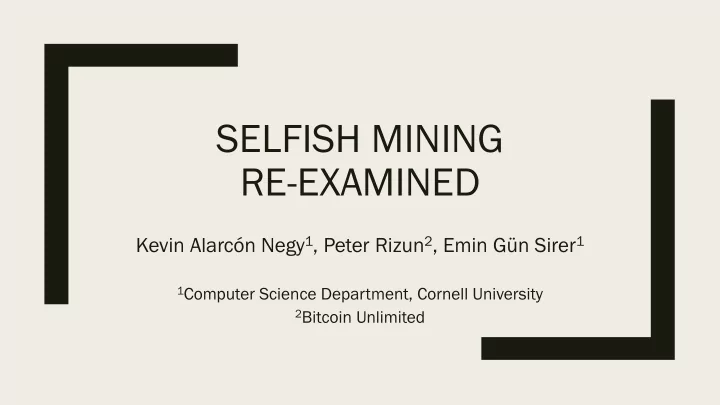

SELFISH MINING RE-EXAMINED Kevin Alarcón Negy 1 , Peter Rizun 2 , Emin Gün Sirer 1 1 Computer Science Department, Cornell University 2 Bitcoin Unlimited
Bitcoin folk theorems ■ Incentive compatibility ■ Hash power is proportional to winnings ■ Joining a mining pool does not increase chance of winning
Selfish mining ■ Showed that deviant mining could be more profitable than following the Bitcoin protocol for minority miners ■ The original selfish mining analysis focused only on profitability in the domain of Bitcoin ■ There are ~2000 cryptocurrencies, with different difficulty adjustment algorithms ■ Profitability depends on difficulty adjustment algorithm (DAA)
Critiques of selfish mining ■ Over the years, critics have denied the feasibility of selfish mining with a variety of arguments ■ Ignoring outlandish claims, two worth examining are: 1. Selfish mining is unprofitable because it does not increase per time-unit profits 2. Selfish mining must persist post-difficulty adjustment to be profitable
Our contributions ■ We show that these arguments are false ■ Introduce intermittent selfish mining strategy , which shows that a selfish miner can profit without continuing the attack past a difficulty adjustment ■ Provide comparative analysis of BTC, ETH, XMR, and BCH/BSV DAAs ■ Analyze per time-unit profitability of selfish mining with these DAAs
Intermittent selfish mining ■ Alternate between selfish and honest mining to manipulate block difficulty ■ Phase se one: Selfishly mine to amplify time to next difficulty adjustment ■ Phase se two: Switch to honest mining to profit from lower difficulty ■ Phase two benefits all miners by increase block mint rate
Intermittent selfish mining illustrated
Difficulty vs. timestep An intermittent selfish miner (ISM) causes difficulty to oscillate every adjustment period.
Block win-rate vs. timestep An ISM with α = 49% doubles the number of blocks to adjust difficulty, then immediately profits.
Block win-rate vs. timestep An ISM with α = 49% doubles the number of blocks to adjust difficulty, then immediately profits.
Block win-rate vs. timestep Difficulty adjustment An ISM with α = 49% doubles the number of blocks to adjust difficulty, then immediately profits.
Block win-rate vs. hash rate When γ = 0, an ISM with α = 37% earns more than through honest mining per time-unit.
Difficulty Adjustment Algorithm Analysis
1. Period-based • Period-based • Incrementally-extrapolated • Sliding-window
1. Period-based • Period-based • Incrementally-extrapolated • Sliding-window
1. Period-based • Period-based • Incrementally-extrapolated • Sliding-window Bitcoin: 𝑥 = 2016
1. Period-based • Period-based • Incrementally-extrapolated • Sliding-window τ 𝑞−1 ∗ 𝐺 𝑢𝑗𝑛𝑓 −𝐸 𝑢𝑗𝑛𝑓 Bitcoin: τ 𝑞 = (τ 𝑓𝑦𝑞. ∗𝑥)
2. Incrementally-extrapolated • Period-based • Incrementally-extrapolated • Sliding-window
2. Incrementally-extrapolated • Period-based • Incrementally-extrapolated • Sliding-window
2. Incrementally-extrapolated • Period-based • Incrementally-extrapolated • Sliding-window τ 𝐺 𝐻 𝑢𝑗𝑛𝑓 −𝐺 𝑢𝑗𝑛𝑓 Ethereum: τ 𝐻 = τ 𝐺 + 2048 ∗ 1 − 9
2. Incrementally-extrapolated • Period-based • Incrementally-extrapolated • Sliding-window τ 𝐺 𝐻 𝑢𝑗𝑛𝑓 −𝐺 𝑢𝑗𝑛𝑓 Ethereum: τ 𝐻 = τ 𝐺 + 2048 ∗ 1 − 9 Adjustment factor
3. Sliding-window • Period-based • Incrementally-extrapolated • Sliding-window
3. Sliding-window • Period-based • Incrementally-extrapolated • Sliding-window
3. Sliding-window • Period-based • Incrementally-extrapolated • Sliding-window BSV/BCH: 𝑥 = 144 XMR: 𝑥 = 600
3. Sliding-window • Period-based • Incrementally-extrapolated • Sliding-window 𝑜+𝑥 τ 𝑗 𝑜+𝑥 τ 𝑗 ∗120+ 𝐻 𝑢𝑗𝑛𝑓 −𝐷 𝑢𝑗𝑛𝑓 −1 𝑗=𝑜 𝑗=𝑜 BSV/BCH: XMR: 𝐻 𝑢𝑗𝑛𝑓 −𝐷 𝑢𝑗𝑛𝑓 𝐻 𝑢𝑗𝑛𝑓 −𝐷 𝑢𝑗𝑛𝑓
Evaluation ■ How effective are DAAs at adjusting difficulty if a substantial amount of hash power is introduced to the network? ■ How does difficulty affect the block win-rate of a new miner? ■ How do these DAAs react to a new selfish miner?
Difficulty adjustment with a new honest miner
Block win-rate of a new honest miner
Block win-rate of a new selfish miner
Relative revenue of a new selfish miner
Findings ■ Selfish mining does not need to persist past a difficulty adjustment to be profitable ■ Above a threshold, selfish mining is profitable per time-unit regardless of DAA choice ■ The choice of DAAs can exacerbate the selfish mining threat ■ Ethereum is vulnerable due to uncle block rewards
Summary ■ Introduced novel intermittent selfish mining strategy ■ Provided a taxonomy for difficulty adjustment algorithms ■ Analyzed the profitability of selfish mining with various DAAs
Whither selfish mining? ■ Deviant miners do not self-report ■ Miners have stake in the system and after-effects are unknown ■ Miners may lack know-how to implement selfish mining ■ For popular cryptocurrencies, the hash power required is too expensive for a single adversary to acquire
Gamma values ■ γ : proportion of honest miners who mine on the selfish block in a fork ■ γ = 1 : selfish miner wins all forks ■ γ = 0 : selfish miner loses all forks ■ γ < 0 : nonsense
Difficulty adjustment with a new selfish miner
Difficulty adjustment with an existing selfish miner
Block win-rate of an existing selfish miner
Block win-rate of an existing selfish miner
Recommend
More recommend